Following on from the previous article referencing the March 15 Christchurch shootings, we can view Resilience as applied to not only Christchurch but all of NZ in a practical way by using this incident as a case study… and this diagram by www.resorgs.org.nz helps us unpack it.
One could argue that Christchurch and indeed New Zealand were lacking in some of these factors, yet they have thus far been credited and applauded for their undeniable resilience. So are some of these more important than others and what, if anything, is missing from this diagram?
Without question, outstanding leadership has been shown which has shaped NZ’s response to the shootings in Christchurch. And the concise and focused decision making that followed was undoubtedly enabled by NZ PM Jacinda Ardern’s response to the crisis. She is, by nature, an inclusive leader, yet it could be argued that much more needed to be present to unlock the community and global engagement that followed. It is very likely, that this golden ingredient was values. Values that were real, outspoken and upheld by a leader who ‘walked the talk’. But it wasn’t just NZ’s values that brought people together, it was some of the fundamental basic values of humanity that have echoed around the globe. Being kind to one another, helping those in need, having compassion and empathy and .. having zero tolerance for those unfairly persecuting others.
Kiwi’s have often been applauded for their innovation and creativity, not necessarily because it’s greater than any other country but perhaps because with so few people, it stands out. Regardless, this incident spurred some creative and innovative responses, enabled by social media. Take for instance, Austrailian cartoonist….. image of the fern, with leaves representing each of those who lost their lives. Or facebook posts on Queenstown community pages offering to walk Muslims to bus stops or give them rides to places if they feel unsafe. People have responded in numerous ways to help, over and above fundraising the highest amount of money ever recorded on a ‘Go Fund Me’ page. It could be said that this incident has touched all New Zealanders.
They have also certainly begun breaking silos and have a clear Unity of purpose as described by NZ Prime Minister, saying ‘We should all feel safe here. They are us.”
Where New Zealand probably wasn’t as strong was in the situational awareness, internal resources (if we don’t include human values in here), having strategies in place for this or leveraging knowledge. These have certainly received attention since the event, as will the equivalent of stress testing plans, and being proactive.
That being said though, without a specific strategic response to such an event in real time, the general public self assembled in an extraordinary way to help those injured, impede the gunman’s progress and take vital steps that led to his capture. In systems terms, it became a self-organising system of the highest calibre. A tell-tale by product of strong leadership, occurring real time, BEFORE the Prime Minister’s response. One might assume then, that despite whatever problems NZ may have in other areas, a lot is going right ie basic culture.
So back to these resilience indicators and what we can take from this for our teams and our companies. It appears that some of these indicators carry more weight than others. The triangle as depicted places Leadership at the tip of the triangle, which rightly signifies the critical role you, as a leader, holds when it comes to creating resilience in your team.
From this abbreviated case study we can see that leadership, visible values, team members taking ownership by self organising to do what needs to be done and engagement, all enabled the other aspects to be present in a crisis situation.







